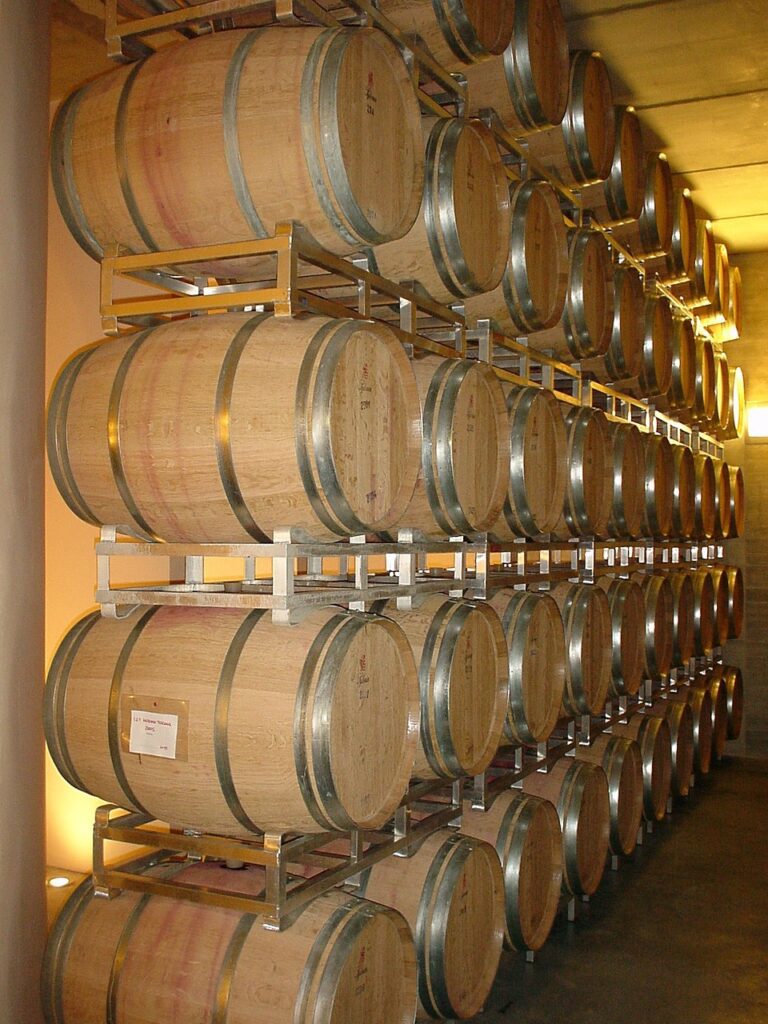Pinking, or the appearance of abnormal pink colouring in white wines, is a frequent fault in varieties such as Sauvignon blanc, Chenin blanc, Chardonnay and Colombard. The potential risk of this defect appearing at bottling depends on the conditions adopted during the pre-fermentation phase.
What is pinking?
Pinking refers to a pink colour appearance in white wines after contact with air. The intensity of the pink varies from pinkish to salmon-red blush and usually does not result in any change in wine aroma and taste, only colour. Although the exact mechanism is not yet well known, wine exposure to oxygen and phenols are involved. Recent studies conclude that the compound responsible for this fault is the anthocyanin malvidin-3-O-glucoside present in small concentrations (∼ 0.3 mg/L) in white wines produced under reductive conditions. That is why wines produced under reductive conditions are among the most susceptible. Other studies speculate that more compounds can be involved.

What are the factors increasing wine predisposition to pinking?
Grape variety
Studies conducted in several wine-growing countries have shown a varietal predisposition to pinking affecting different white grape varieties. Not only the most sensitive Sauvignon blanc, but other varietals such as Chardonnay, Chenin blanc, Colombard, Sémillon, Pinot gris, Verdejo and Riesling should be included in the list of those of major international importance that are susceptible to pinking.
Grape ripeness
According to a recent study at Nietvoorbij Institute in South Africa, the potential for pinking increased with the degree of ripeness. This can be explained by a more significant accumulation of phenols in the berry and their increased extractability as grapes ripen.
Pressing and skin contact
Any process that leads to greater phenolic extraction potentially increases wine susceptibility to pinking i.e., a high number of press rotations, high press pressure, presence of stems, skin contact, duration of skin contact, etcetera.
Reductive conditions
As already mentioned, pinking occurs more frequently in wines made in reductive conditions. The use of dry ice, inert gases, SO2 and ascorbic acid during vinification helps to preserve a higher phenolic content in the wine that, if accidentally exposed to oxygen during cellaring and bottling, is more prone to oxidative phenomena such as pinking and browning. When adopting reductive vinification, protecting wine from oxygen until packaging is crucial.
How to prevent pinking during harvest?
Besides carefully selecting harvest time and vinification conditions, a juice fining strategy can significantly reduce the risk of pinking. According to Ugliano (2019), juice treatment with a combination of pea protein and PVPP is very effective in preventing wine pinking. Removing copper by PVI/PVP addition can be another approach. Pinking results from non-enzymatic oxidation or chemical oxidation of phenolic compounds in which copper and iron play a key role. Lowering the concentration of these metals, PVI/PVP co-polymers can mitigate the risk of pinking.

How to detect if a wine is susceptible to pinking?
There are various assays for pinking around the world, all the variations of the test established by Simpson in 1977 that is based on the measurement of an increase of optical density at 500 nm induced by the addition to the wine of a solution of hydrogen peroxide. The test can take between eight and 24 hours. If you don’t have time and are satisfied with a rough estimate, try the following method:
Quick method
- 150 mL of the test wine.
- 375 mL of 3% hydrogen peroxide.
- Place in a laboratory oven at 40°C for 15 minutes.
If the wine is subject to pinking, the colour will be pink at the end of the test.
How to prevent pinking in wine?
When wine is susceptible to pinking:
- Limit oxygen exposure.
- Protect wine by increasing free SO2 content to 40 – 45 mg/L.
- Remove pinking precursors by fining with PVPP, potassium caseinate or carbon.
- At bottling, use ascorbic acid in conjunction with SO2.
- Treat wine pre-bottling using Citrostab rH that contains ascorbic acid, citric acid, potassium metabisulfite and tannin. Each component in the blend reacts in synergy with the others in a calibrated way to block any oxidation that could occur due to oxygen absorption during bottling.
References
- The Australian Wine Research Institute. Pinking https://www.awri.com.au/industry_support/winemaking_resources/frequently_asked_questions/pinking/.
- Cosme, F.; Andrea-Silva, J.; Filipe-Ribeiro, L.; Moreira, A. S. P.; Malheiro, A. C.; Coimbra, M. A.; Domingues, M. R. M.; Nunes, F. M. The origin of pinking phenomena in white wines: An update. BIO Web Conf. 2019, 12, 02013.
- Coetzee C. Should we be afraid of pinking? https://Should we be afraid of pinking? – Sauvignon Blanc South Africa.
- Hirlam K.; Scrimgeour N.; Wilkes E. Removing metals from wine using PVI/PVP. https://242 Technical Review October 2019 (awri.com.au).
- Lamuela-Raventó, R. M.; Huix-Blanquera, M.; Waterhouse, A. L. Treatments for pinking alteration in white wines. Am. J. Enol. Vitic. 2001, 52 (2), 156 LP-158.
- Nel A.P.; Toit, W. Du; Jaarsveld F.P. van. Pinking in White Wines: A Review. S. Afr. J. Enol.Vitic. 2020, 41 (2), 151-157.
- Nel, A.; Van Jaarsveld, F. Guidelines to reduce pinking potential in white wines. https://wineland.co.za/guidelines-reduce-pinking-potential-white-wines/.
- Simpson, R. F. Oxidative Pinking in White Wines. Vitis 1977, 16, 286-294.
- Ugliano M. White wines longevity; new predictive and decision supporting tools. Enoforum 2019.
– For more information, contact Lida Malandra at lida.malandra@enartis.co.za.
Click here to get your copy of WineLand Magazine and here to subscribe to our newsletter.













